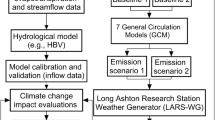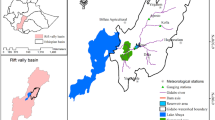Abstract
In regions where the Mediterranean climate prevails, the agricultural sector and agricultural-operated dam reservoirs are threatened by climate change. In this respect, the prediction of hydro-meteorological changes that may occur in surface water resources under climate change scenarios is essential to examine the sustainability of reservoirs. In this paper, Demirköprü reservoir in the Gediz Basin/Turkey, a reservoir operated for irrigation purposes, was analyzed against the RCP4.5 and RCP 8.5 scenarios specified in the AR5 report of the IPCC. Projection period was evaluated as 2016-2050 water year period. First, statistical downscaling, Bayesian model averaging and quantile delta mapping bias correction techniques were respectively applied to monthly total precipitation and monthly average temperatures of meteorological stations in the region using 12 GCMs. According to RCP4.5 and RCP8.5, negligible reductions in precipitation are foreseen, while significant increases of 1.3 and 1.8 °C, respectively, are projected for temperatures under the same scenarios. Following the calibration of rainfall-runoff models for the sub-basins feeding the reservoir, streamflow simulations were also performed with projected precipitation and temperatures. In particular, according to the RCP 8.5 scenario, reservoir inflows during the period 2016-2050 could be reduced by 21% compared to the reference scenario results. Finally, the projected crop water demands and hydro-meteorological changes are evaluated together and the reservoir performances are examined using various indices. Assuming that the performance of the past irrigation yields will not change in the future, it is foreseen that reservoir’s sustainability will decrease by 16% under the RCP8.5 scenario. Even if the irrigation efficiency is increased by 40%, the reservoir cannot reach past sustainability characteristics.






Similar content being viewed by others
References
Aich V, Liersch S, Vetter T et al (2014) Comparing impacts of climate change on streamflow in four large African river basins. Hydrol Earth Syst Sci 18:1305–1321
Akkuzu E, Unal HB, Karatas BS, Avci M, Asik S (2007) General irrigation planning performance of water user associations in the Gediz Basin in Turkey. J Irrig Drain Eng 133(1):17–26
Brekke LD, Maurer EP, Anderson JD et al (2009) Assessing reservoir operations risk under climate change. Water Resour Res 45:1–16
Cannon AJ, Sobie SR, Murdock TQ (2015) Bias correction of GCM precipitation by quantile mapping: how well do methods preserve changes in quantiles and extremes? J Clim 28:6938–6959
Dibike YB, Gachon P, St-Hilaire A et al (2007) Uncertainty analysis of statistically downscaled temperature and precipitation regimes in Northern Canada. Theor Appl Climatol 91:149–170
DSİ (2006) Marmara Gölü Fizibilite Raporu (in Turkish, General Directorate of State Hydraulic Works-Marmara Lake Feasibility Report)
Fischer G, Tubiello FN, Velthuizen H, Wiberg DA (2007) Climate change impacts on irrigation water requirements: effects of mitigation, 1990–2080. Technol Forecast Soc Chang 74:1083–1107
Fistikoglu O, Okkan U (2011) Statistical downscaling of monthly precipitation using NCEP/NCAR reanalysis data for Tahtali River basin in Turkey. J Hydrol Eng 16:157–164
Knutti R, Abramowitz G, Collins M, et al (2010) Good practice guidance paper on assessing and combining multi model climate projections. IPCC Expert Meet Assess Comb Multi Model Clim Proj 15pp
Koirala S, Hirabayashi Y, Mahendran R, Kanae S (2014) Global assessment of agreement among streamflow projections using CMIP5 model outputs. Environ Res Lett 9(6):1–12
Kwon W, Baek H, Park E (2010) Probabilistic regional climate change projections using Bayesian model averaging. In: IPCC Expert Meeting on Assessing and Combining Multi Model Climate Projections. Boulder, Colorado, USA, p 69–70
Li L, Xu H, Chen X, Simonovic SP (2010) Streamflow forecast and reservoir operation performance assessment under climate change. Water Resour Manag 24:83–104
Loucks DP (1997) Quantifying trends in system sustainability. Hydrol Sci J 42(4):513–530
McMahon TA, Adeloye AJ, Sen-Lin Z (2006) Understanding performance measures of reservoirs. J Hydrol 324:359–382
Moriasi DN, Arnold JG, Van Liew MW et al (2007) Model evaluation guidelines for systematic quantification of accuracy in watershed simulations. Trans ASABE 50:885–900
Okkan U, Fistikoglu O (2014) Evaluating climate change effects on runoff by statistical downscaling and hydrological model GR2M. Theor Appl Climatol 117:343–361
Okkan U, Inan G (2015) Statistical downscaling of monthly reservoir inflows for Kemer watershed in Turkey: use of machine learning methods, multiple GCMs and emission scenarios. Int J Climatol 35:3274–3295
Okkan U, Kirdemir U (2016) Downscaling of monthly precipitation using CMIP5 climate models operated under RCPs. Meteorol Appl 23:514–528
Olesen JE, Bindi M (2002) Consequences of climate change for European agricultural productivity, land use and policy. Eur J Agron 16:239–262
Parry ML, Rosenzweig C, Iglesias A et al (2004) Effects of climate change on global food production under SRES emissions and socio-economic scenarios. Glob Environ Chang 14:53–67
Raftery AE, Gneiting T, Balabdaoui F, Polakowski M (2005) Using Bayesian model averaging to calibrate forecast ensembles. Mon Weather Rev 133:1155–1174
Raje D, Mujumdar PP (2010) Reservoir performance under uncertainty in hydrologic impacts of climate change. Adv Water Resour 33:312–326
Sachindra DA, Huang F, Barton A, Perera BJC (2014) Statistical downscaling of general circulation model outputs to precipitation-part 2: bias-correction and future projections. Int J Climatol 34:3282–3303
Satterthwaite D (2009) The implications of population growth and urbanization for climate change. Environ Urban 21(2):545–567
Solis SS, McKinney DC, Loucks DP (2011) Sustainability index for water resources planning and management. J Water Res Plan and Manag 137(5):381–390
Stocker TF, Qin D, Plattner GK, Tignor M, Allen SK, Boschung J (2013) Climate change 2013. The Physical Science Basis. Working Group I Contribution to the Fifth Assessment Report of the Intergovernmental Panel on Climate Change
Vuuren DPV, Edmonds J, Kainuma M, Riahi K, Thomson et al (2011) The representative concentration pathways: an overview. Clim Chang 109:5–31
Wilby RL, Dawson CW, Barrow EM (2002) SDSM- a decision support tool for the assessment of regional climate change impacts. Environ Model Softw 17:145–157
Xu CY, Singh VP (2001) Evaluation and generalization of temperature-based methods for calculating evaporation. Hydrol Process 15:305–319
Zhang L, Potter N, Hickel K et al (2008) Water balance modeling over variable time scales based on the Budyko framework - model development and testing. J Hydrol 360:117–131
Acknowledgments
This study was funded by the Scientific and Technological Research Council of Turkey under Grant No.114Y716. The authors also wish to thank the editors and the two anonymous reviewers for their constructive suggestions that improved the quality of our paper.
Author information
Authors and Affiliations
Corresponding author
Rights and permissions
About this article
Cite this article
Okkan, U., Kirdemir, U. Investigation of the Behavior of an Agricultural-Operated Dam Reservoir Under RCP Scenarios of AR5-IPCC. Water Resour Manage 32, 2847–2866 (2018). https://doi.org/10.1007/s11269-018-1962-0
Received:
Accepted:
Published:
Issue Date:
DOI: https://doi.org/10.1007/s11269-018-1962-0




